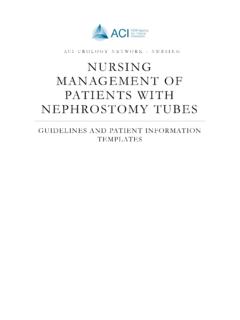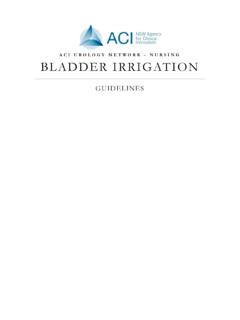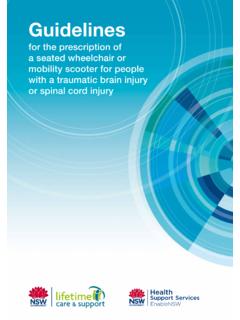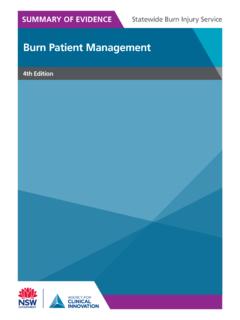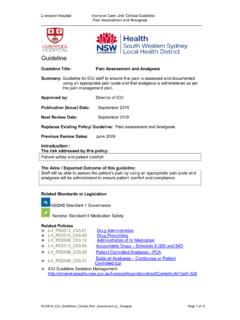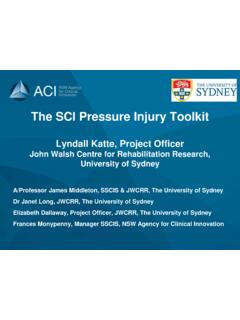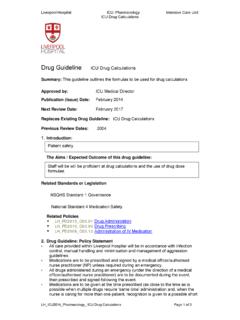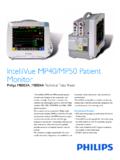Transcription of Pulse Contour Cardiac Output (PiCCO) Learning Package
1 2016 Paula Nekic, CNE ICU, Liverpool Hospital SWSLHD 2/29/2016 Pulse Contour Cardiac Output ( picco ) Learning Package Liverpool Hospital Intensive Care: Learning packages Intensive Care Unit Pulse Contour Cardiac Output ( picco ) Learning Package LH_ICU2016_Learning_Package_Pulse_Contou r_Cardiac_Output_Learning_Package Page 2 CONTENTS Haemodynamic calculations Definitions 3 Indications for picco 4 How does picco work? 4 What does picco do? 8 Set up 10 Troubleshooting 14 Learning activities 16 Reference List 17 Liverpool Hospital Intensive Care: Learning packages Intensive Care Unit Pulse Contour Cardiac Output ( picco ) Learning Package LH_ICU2016_Learning_Package_Pulse_Contou r_Cardiac_Output_Learning_Package Page 3 INTRODUCTION picco is an acronym for Pulse Contour Cardiac Output .
2 It enables assessment of the patient s haemodynamic status to guide fluid or vasoactive drug therapy. picco uses a combination of two techniques for advanced haemodynamic and volumetric monitoring Transpulmonary thermodilution Pulse Contour analysis The thermodilution technique calculates volumetric measurements of preload and Cardiac Output . Pulse Contour analysis provides continuous Cardiac Output and stroke volume variation. picco requires the insertion of a central venous pressure (CVP) catheter and a thermodilution arterial line. The arterial line can be placed in the axillary, brachial, femoral or radial artery, although radial insertion requires a longer catheter. picco not only gives information about Cardiac Output but can give measurements to assess preload, contractility, afterload and extravascular lung water.
3 Although these measurements are derived from calculations they can be used in combination with clinical assessment. HAEMODYNAMIC CALCULATIONS: DEFINITIONS Cardiac Output (CO) CO is a measurement of Cardiac function It can be used to assess the degree of Cardiac compromise and response to therapies It is the amount of blood ejected by the left ventricle per min It is determined by heart rate x stroke volume STROKE VOLUME Amount of blood ejected from the heart with each contraction Influenced by preload, afterload and contractility PRELOAD Amount of stretch or volume on heart before contraction Reflects the volume status of the patient The preload that provides optimal Cardiac Output varies from each patient and is dependent on ventricular function AFTERLOAD Resistance the left ventricle must overcome to circulate blood Is the impedance to left ventricular contraction, is assessed by measuring systemic vascular resistance (SVR)
4 It is the degree of constriction or dilatation of the arterial circulation Liverpool Hospital Intensive Care: Learning packages Intensive Care Unit Pulse Contour Cardiac Output ( picco ) Learning Package LH_ICU2016_Learning_Package_Pulse_Contou r_Cardiac_Output_Learning_Package Page 4 CONTRACTILITY Is the ability of the myocardial muscle fibres to shorten independent of preload and afterload It is the ability of the heart to contract and the force it needs to do so INDICATIONS FOR picco Shock: cardiogenic, hypovolaemic, septic Sepsis Trauma Pulmonary oedema Acute lung injury Burns Any condition that requires assessment of haemodynamic and/ or volumetric function HOW DOES picco WORK picco uses a combination of two techniques for advanced haemodynamic and volumetric monitoring Transpulmonary thermodilution Pulse Contour analysis picco is intended for monitoring of haemodynamic variables to aid cardiovascular management and support in critically ill patients with circulatory The picco system continually estimates the stroke volume from the arterial waveform, using the arterial catheter 6.
5 Following an initial calibration process using thermodilution The initial transpulmonary thermodilution calibrates the parameters & the algorithm is then capable of computing each single stroke volume Provides continuous beat by beat parameters which are obtained from the shape of the arterial pressure wave. The area under the arterial curve during systole, minus the background diastolic area, is assumed to be proportional to the stroke volume. Cardiac Output is then derived from the stroke volume and heart rate. picco measures volume status by calculating Intrathoracic Blood Volume (ITBV) and extravascular lung water (EVLW) through transpulmonary thermodilution. 6 An added advantage of picco is the ability to measure EVLW and alert clinicians to early development of pulmonary Clinical data obtained from picco is used to guide clinical management of the patient through volume loading, volume reduction and use of inotropes/ TRANSPULMONARY THERMODILUTION Injection of cold saline through a CVC.
6 Mixes with the blood volume & passes through the R) heart, through the pulmonary vessels & back through the L) heart Just after the L) heart the arterial line measures the drop in blood temperature & from this we obtain a Thermodilution Curve Using the Stewart-Hamilton Equation the area under this curve = CO Liverpool Hospital Intensive Care: Learning packages Intensive Care Unit Pulse Contour Cardiac Output ( picco ) Learning Package LH_ICU2016_Learning_Package_Pulse_Contou r_Cardiac_Output_Learning_Package Page 5 Stewart Hamilton equation Adapted Pulsion Medical 2008 Transpulmonary thermodilution: Volumetric parameters All volumetric parameters are obtained by advanced analysis of the thermodilution curve: Below shows the graph of change in temp (inverted) against time Adapted Pulsion Medical MTt= Mean Transit time: half the indicator has passed the point of injection in the artery DSt= Down slope time: the exponential time of the down slope curve Tb CO Calculation: Area under the Thermodilution Curve injection dtTKV)T(TCObiibTDa Tb = Blood temperature Ti = Injectate temperature Vi = Injectate volume Tb.
7 Dt = Area under the thermodilution curve K = Correction constant, made up of specific weight and specific heat of blood and injectate Liverpool Hospital Intensive Care: Learning packages Intensive Care Unit Pulse Contour Cardiac Output ( picco ) Learning Package LH_ICU2016_Learning_Package_Pulse_Contou r_Cardiac_Output_Learning_Package Page 6 Firstly Cardiac Output is calculated from the Stewart Hamilton equation the area under the top graph. You have a value for the Cardiac Output in volume/per unit interpreting the bottom graph gives you some values (MTt and DSt) in seconds. The product of volume/unit time x time= volume. The product of CO X MTt represents the total volume traversed by the indicator total volume between site of injection and detection. The greater the volume the bolus has to travel through the longer it will take.
8 The product of CO x DSt represents the largest individual mixing volume in a series of indicator mixing chambers. After injection, the indicator passes the following intrathoracic compartments: Adapted Pulsion Medical ITTV= Intrathoracic thermal volume and is the sum of all the volumes in diagram PTV= Pulmonary thermal volume RAEDV= Right atrial end diastolic volume RVEDV= Right ventricular end diastolic volume LAEDV= Left atrial end diastolic volume LVEDV= Left ventricular end diastolic volume The intrathoracic compartments can be considered as a series of mixing chambers for the distribution of the injected indicator (intrathoracic thermal volume). The largest mixing chamber in this series are the lungs, here the indicator (cold) has it largest distribution volume (largest thermal volume). CV Bolus Lungs Thermodilution curve measured with arterial catheter Liverpool Hospital Intensive Care: Learning packages Intensive Care Unit Pulse Contour Cardiac Output ( picco ) Learning Package LH_ICU2016_Learning_Package_Pulse_Contou r_Cardiac_Output_Learning_Package Page 7 Pulse Contour ANALYSIS: Continuous analysis The picco system continually estimates the stroke volume from the arterial waveform, using an arterial catheter.
9 Cardiac Output is then estimated from the stroke volume and heart rate. Provides continuous beat by beat parameters which are obtained from the shape of the arterial pressure wave The area under the arterial curve during systole, minus the background diastolic area, is assumed to be proportional to the stroke volume. This means that the stroke volume and thus the Cardiac Output can be measured beat to beat. The initial transpulmonary thermodilution calibrates the parameters & the algorithm is then capable of computing each single stroke volume Continuous CO readings are achieved using the area under the systolic part of the curve, a calibration factor (cal) derived from the thermodilution run, the heart rate (HR) and the individual s aortic compliance (which is termed C (p) and characterised by the thermodilution CO and the measured BP).
10 Calculation of Beat by Beat Pulse Contour Cardiac Output Rise and fall of the blood pressure curve is also dependent on the patient s individual aortic compliance. After calibration, the Pulse Contour Algorithm is able to follow the Cardiac Output beat by beat. Liverpool Hospital Intensive Care: Learning packages Intensive Care Unit Pulse Contour Cardiac Output ( picco ) Learning Package LH_ICU2016_Learning_Package_Pulse_Contou r_Cardiac_Output_Learning_Package Page 8 WHAT DOES picco DO? From taking three values from the temperature vs. time graph (CO, MTt, DSt) the picco can estimate: Cardiac Output Preload: ITBV Degree of Pulmonary oedema: EVLWI PARAMETERS MEASURED & NORMAL VALUES Thermodilution Parameters CO Cardiac Output : 4 - 8litres/min CI Cardiac Index : 3- 5litres/min/m Preload GEDI Global end diastolic index: 680- 800ml/m ITBVI Intra thoracic blood volume index: 850-1000ml/m Pulmonary oedema ELWI Extravascular lung water index: 3-7mls/kg PVPI - Pulmonary vascular permeability index: Contractility CFI - Cardiac function index: GEF - Global ejection fraction: 25- 35% Pulse Contour Parameters Flow PCC - Pulse Contour Cardiac Output ABP - Arterial blood pressure HR - Heart rate SV - Stroke volume: 50-110mls Volume responsiveness SVV - Stroke volume variation.
